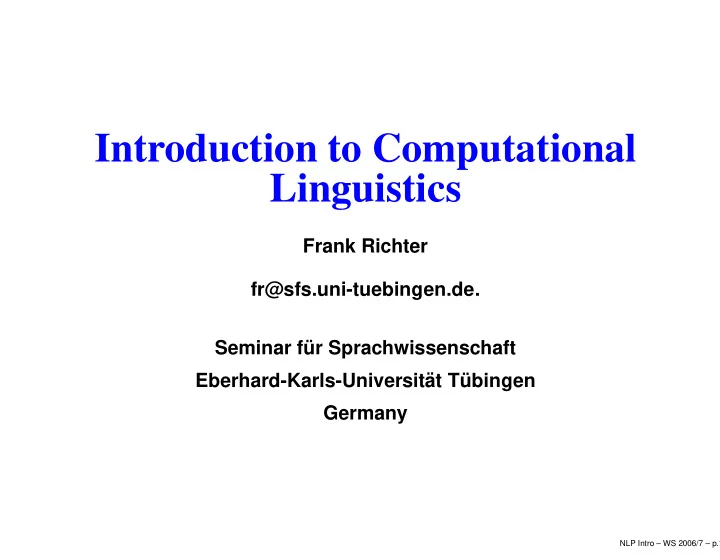

Introduction to Computational Linguistics Frank Richter fr@sfs.uni-tuebingen.de. Seminar f¨ ur Sprachwissenschaft Eberhard-Karls-Universit¨ at T¨ ubingen Germany NLP Intro – WS 2006/7 – p.1
Course Goals First (largely non-technical) introduction to the field of computational linguistics and its history Survey of natural language processing applications In-depth look at machine translation as a means to illustrate the major tasks for natural language processing Presentation of tools and resources needed for natural language processing applications NLP Intro – WS 2006/7 – p.2
The Name of the Field Computational Linguistics Natural Language Processing Human Language Technology Language Engineering NLP Intro – WS 2006/7 – p.3
The History of the Field Not surprisingly, the history of Computational Linguistics is closely connected to the development of the digital computer. The theoretical foundations of Computational Linguistics are in the field of mathematical linguistics and formal language theory and in the field of information theory. The first application of Computational Linguistics was in the area of machine translation. Therefore, the first professional organization was called Association for Machine Translation and Computational Linguistics . NLP Intro – WS 2006/7 – p.4
The History of the Digital Computer 1939 John J. Atanasoff designs a prototype for the ABC (Atanasoff-Berry Computer) with the help of graduate student Clifford Berry at Iowa State College. In 1973 a judge ruled it the first automatic digital computer. 1941 Colossus computer is designed by Alan M. Turing and built by Thomas H. Flowers and Maxwell H.A. Newman. NLP Intro – WS 2006/7 – p.5
The History of the Digital Computer (2) 1941 Konrad Zuse builds the Z3 computer in Germany, the first calculating machine with automatic control of its operations. 1946 ENIAC (Electronic Numerical Integrator and Computer), with 18,000 vacuum tubes, is dedicated at the U. of Pennsylvania. It was 8 by 100 feet and weighed 80 tons. It could do 5,000 additions and 360 multiplications per second. NLP Intro – WS 2006/7 – p.6
The First NLP Application Bi-lingual Dictionaries for Word-to-Word Machine Translation 1947 Donald Booth and D.H.V. Britten worked out a detailed code for realizing dictionary translation on a digital computer. 1948 R.H. Richens worked out a stem-affix encoding with a longest-match strategy for stem identification and translation. NLP Intro – WS 2006/7 – p.7
Recommend
More recommend